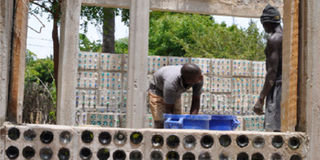Turning waste into beauty in Watamu

Men use bottles to construct a structure at Watamu Marine Centre.
Plastics, empty wine bottles, slippers, rubber soles and more would conventionally define a cluttered compound but not in Steve Trott’s. Whereas you will be using bricks, sand and cement, Trott and his group of builders partly use bottles to put up a structure. Trott is a marine biologist.
Within the composition of a brick are nicely aligned bottles, of different colours. Right opposite the small house that will later on serve an artistic purpose, is a creative backdrop modelled out as a dolphin.
On the outside, it is all blue and makes for stunning photo moments. That is before you see the inside. The interior face is multi-coloured. It is ‘Bottlenose Dolphin’ which was put together by artist and sculptor Andrew MacNaughton using 1, 000 glass bottles.
Away from the artificial dolphin, your mind will be opened to the possibilities of recycling once you keep in Trott’s company at Watamu Marine Association’s Eco World Recycling Centre.
Eco friendly initiative
Watamu is a small town in Malindi, touching the Indian Ocean coast at its mouth between the Blue Lagoon and Watamu Bay. And Trott’s efforts are to clean the ocean of the waste that is discarded there thanks to numerous beach hotels and other hospitality facilities.
He is partnering with other hotel owners by collecting waste from them and putting it to use because as he further explains, the same waste is dangerous to marine life such as dolphins and sharks. The locals who collect the waste, earn from this and for working at the recycling centre. What is more, is that the creative mind can earn for turning the waste products into income-generating items.
The structure being put up will be a display point for artists who will be working at the centre and using their creative juices to turn waste into cash. “When we finally put up a gallery for local artists, we expect it to become a public attraction,” Trott says as he explains ways through which charcoal can be made from other products other than trees.
There is a bio-digester at the centre through which rubber and other wastes are burnt to produce energy for combustion use. “One of the problems Watamu is grappling with is cutting down of trees for charcoal, which is a problem to both the environment and tourism,” he explains.
Marine life is under threat because when non-biodegradable wastes such as plastics are fed on by sea turtles, they are hard to digest and eventually cause intestinal complications that lead to their death. Dolphins and whales face the same threat and in effect to the coastal tourism.
Overcoming challenges
The solution to the challenge at Watamu lay in a solid waste management project undertaken by Watamu Marine Association in 2009. The efforts were supported by IUCN Netherlands and African Fund for Endangered Wildlife Kenya Limited. With the support, a recycling machine was purchased for crushing plastic waste and the Blue Team waste collectors and recyclers were formed, made up from impoverished members of local youth and women’s groups.
“The 25 Blue Team members carry out weekly beach clean-ups and work to keep the village roadsides free of rubbish. They are mostly sponsored by local hotels and businesses which sustains their operations,” Trott adds.
In one clean-up, they collected 3,124kg of marine debris from the beaches which are important sea turtle nesting areas. The centre is generating income from the sale of recyclables.
Future
Trott says they are planning to develop the centre as a demo site for small environmental technologies and best practices. This will include glass blowing, composting, permaculture, bio-fuel briquette making as an alternative to charcoal, bio-gas production from manure and tree nurseries.
At the moment, WMA also works with Ocean Sole in Nairobi which takes discarded flip-flops and other marine flotsam and recycles these into products ranging from accessories and jewellery to one-off sculptures.




